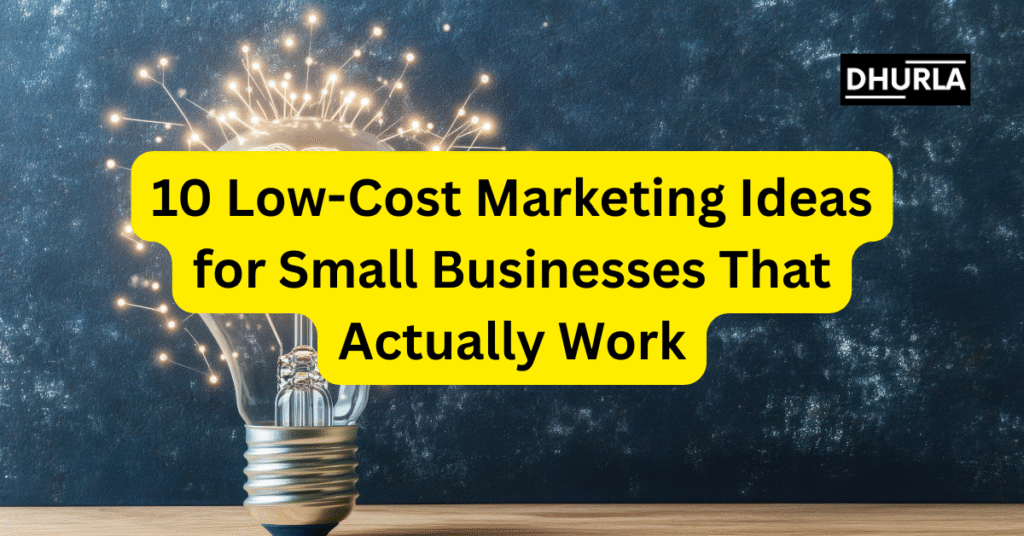10 Low-Cost Marketing Ideas for Small Businesses That Actually Work

Small businesses often face tight budgets. Marketing can feel expensive and out of reach. But you don’t need a big budget to grow your brand. There are plenty of low-cost marketing ideas that work well. These strategies are simple, effective, and budget-friendly.
Table of Contents
In this blog, we’ll explore 10 low-cost marketing ideas for small businesses. Each idea is practical and proven to drive results. Let’s dive in!
Why Low-Cost Marketing Matters for Small Businesses
Marketing is essential for growth. It helps you reach new customers. It builds brand awareness. But small businesses can’t always afford pricey ad campaigns. That’s where low-cost marketing comes in. These strategies save money while delivering results. They’re perfect for startups, freelancers, or small shops. You can compete with bigger brands without breaking the bank.
Here are 10 low-cost marketing ideas that actually work.
1. Leverage Social Media Platforms
Social media is free to use. It’s a powerful tool for small businesses. Platforms like Instagram, Facebook, and TikTok let you connect with customers. You can share updates, promotions, or behind-the-scenes content.
How to Do It
- Create profiles on platforms your audience uses.
- Post regularly—aim for 3-5 times a week.
- Share engaging content like photos, videos, or tips.
- Use hashtags to reach more people.
- Interact with followers by replying to comments.
Why It Works
Social media builds trust. It lets customers see your personality. Consistent posting keeps your brand visible. Hashtags and shares expand your reach. Best of all, it’s free or low-cost.
Pro Tip
Try short videos on TikTok or Instagram Reels. They’re quick to make and get lots of views. Use trending sounds to boost engagement.
2. Start a Blog
Blogging is a great way to attract customers. It’s low-cost and boosts your website’s SEO. Search engines like Google love fresh content. A blog helps you rank higher in search results.
How to Do It
- Write about topics your audience cares about.
- Use simple, clear language.
- Include keywords related to your business.
- Post consistently—once a week is a good start.
- Share your blog on social media and email.
Why It Works
Blogs drive traffic to your website. They show you’re an expert in your field. Customers trust businesses that share helpful information. Over time, blogs improve your search rankings.
Pro Tip
Write “how-to” guides or listicles. For example, a bakery could write “5 Easy Dessert Recipes for Beginners.” These attract clicks and shares.
3. Use Email Marketing
Email marketing is affordable and effective. It keeps your business top-of-mind. You can send newsletters, promotions, or updates to customers.
How to Do It
- Collect emails through your website or in-store.
- Use a free or low-cost tool like Mailchimp.
- Send regular emails—once or twice a month.
- Include a clear call-to-action (e.g., “Shop Now”).
- Personalize emails with the customer’s name.
Why It Works
Emails have a high return on investment. They’re direct and personal. Customers are more likely to buy from brands they hear from regularly. Plus, email platforms offer free plans for small lists.
Pro Tip
Offer a discount or freebie to get people to sign up. For example, “Get 10% off your first order when you join our newsletter.”
4. Collaborate with Other Local Businesses
Partnering with local businesses is smart. It’s low-cost and builds community. You can cross-promote to reach new customers.
How to Do It
- Find businesses that complement yours (e.g., a gym and a health food store).
- Offer to promote each other’s services.
- Host joint events or giveaways.
- Share flyers or coupons in each other’s stores.
- Tag each other on social media.
Why It Works
Local partnerships expand your audience. Customers trust recommendations from businesses they know. It’s a win-win for both brands.
Pro Tip
Create a bundle deal. For example, a coffee shop and bookstore could offer a “Coffee & Read” package with a discount.
5. Get Listed on Google Business Profile
Google Business Profile is free. It helps customers find you online. It’s especially great for local businesses like restaurants or shops.
How to Do It
- Sign up for a Google Business Profile.
- Add your business name, address, and hours.
- Upload photos of your products or services.
- Encourage customers to leave reviews.
- Post updates or offers regularly.
Why It Works
Google Business Profile boosts local SEO. It shows your business on Google Maps. Customers can find you when searching “near me.” Reviews build trust and credibility.
Pro Tip
Respond to all reviews, even negative ones. It shows you care about customer feedback.
6. Host a Giveaway or Contest
Giveaways are fun and engaging. They’re a low-cost way to attract attention. You can give away a product, service, or gift card.
How to Do It
- Choose a prize your audience will love.
- Promote the giveaway on social media or email.
- Ask participants to follow, like, or share your post.
- Use a free tool like Rafflecopter to manage entries.
- Announce the winner publicly.
Why It Works
Giveaways create excitement. They encourage people to engage with your brand. Shares and tags spread the word to new audiences.
Pro Tip
Keep entry requirements simple. For example, “Follow us and tag a friend” works better than complex rules.
7. Create Video Content
Videos are highly engaging. They don’t need to be fancy or expensive. You can use your smartphone to create great content.
How to Do It
- Record short videos (30-60 seconds).
- Share tips, tutorials, or product demos.
- Post on YouTube, Instagram, or TikTok.
- Add captions for accessibility.
- Use free editing apps like CapCut.
Why It Works
People love watching videos. They’re more likely to share videos than text posts. Videos also help you connect emotionally with customers.
Pro Tip
Show your face in videos. It makes your brand feel human and relatable.
8. Use Customer Testimonials
Testimonials are powerful. They show real people love your business. They’re free to collect and easy to share.
How to Do It
- Ask happy customers for feedback.
- Use quotes on your website or social media.
- Share video testimonials if possible.
- Always get permission before posting.
- Highlight specific benefits of your product or service.
Why It Works
Testimonials build trust. People believe other customers more than ads. They’re proof your business delivers results.
Pro Tip
Feature testimonials on your homepage. It’s one of the first things visitors see.
9. Offer Referral Discounts
Referrals turn customers into promoters. They’re a low-cost way to get new clients. You reward customers for spreading the word.
How to Do It
- Offer a discount for referring a friend.
- Give both the referrer and the new customer a deal.
- Promote the program on social media or email.
- Use a simple tracking system (e.g., a unique code).
- Keep the process easy and clear.
Why It Works
Referrals are trusted recommendations. People are more likely to try a business their friends recommend. Discounts encourage repeat business.
Pro Tip
Make the reward attractive. For example, “Refer a friend and you both get 20% off!”
10. Optimize Your Website for SEO
A well-optimized website attracts visitors. SEO (search engine optimization) helps you rank higher on Google. It’s low-cost but takes time.
How to Do It
- Use relevant keywords in your content.
- Write clear, descriptive page titles.
- Add alt text to images.
- Ensure your website is mobile-friendly.
- Use free tools like Yoast SEO for guidance.
Why It Works
SEO drives organic traffic. Higher rankings mean more clicks. A user-friendly website keeps visitors engaged.
Pro Tip
Focus on local SEO. Include your city or region in keywords (e.g., “best coffee shop in Seattle”).
Bonus Tips for Success
These low-cost marketing ideas work best when combined. Here are a few extra tips to maximize results:
- Be Consistent: Post regularly on social media and blogs. Consistency builds trust.
- Track Results: Use free tools like Google Analytics to see what works. Adjust your strategy based on data.
- Engage with Customers: Reply to comments and messages. It shows you care.
- Stay Authentic: Be yourself in your marketing. Customers connect with real, human brands.
Common Mistakes to Avoid
Even low-cost marketing can go wrong. Here are pitfalls to watch out for:
- Ignoring Your Audience: Know who your customers are. Tailor your content to their needs.
- Overloading with Ads: Too many promotions annoy people. Balance promotional and helpful content.
- Neglecting Mobile Users: Ensure your website and emails work well on phones.
- Skipping Analytics: If you don’t track results, you won’t know what’s working.
How to Get Started Today
Ready to try these ideas? Start small. Pick one or two strategies from this list. For example, set up a Google Business Profile and post on social media. Track your progress after a month. Once you see results, add another tactic. Over time, these efforts will compound.
Example Plan
- Week 1: Create a Google Business Profile and post on Instagram.
- Week 2: Write your first blog post and share it.
- Week 3: Send your first email newsletter.
- Week 4: Partner with a local business for a giveaway.
This approach keeps things manageable. It also builds momentum.
Why These Ideas Work
Low-cost marketing is about creativity, not cash. These strategies use free or affordable tools. They focus on building relationships. They help you reach customers without big ad spends. Small businesses can compete with larger ones by being smart and consistent.
Final Thoughts
Marketing doesn’t have to be expensive. These 10 low-cost ideas prove it. From social media to SEO, each strategy is simple and effective. Start with one or two ideas. Test, track, and tweak as you go. Over time, you’ll see more traffic, leads, and sales. Your small business can grow without a big budget. Get started today and watch your brand thrive!
